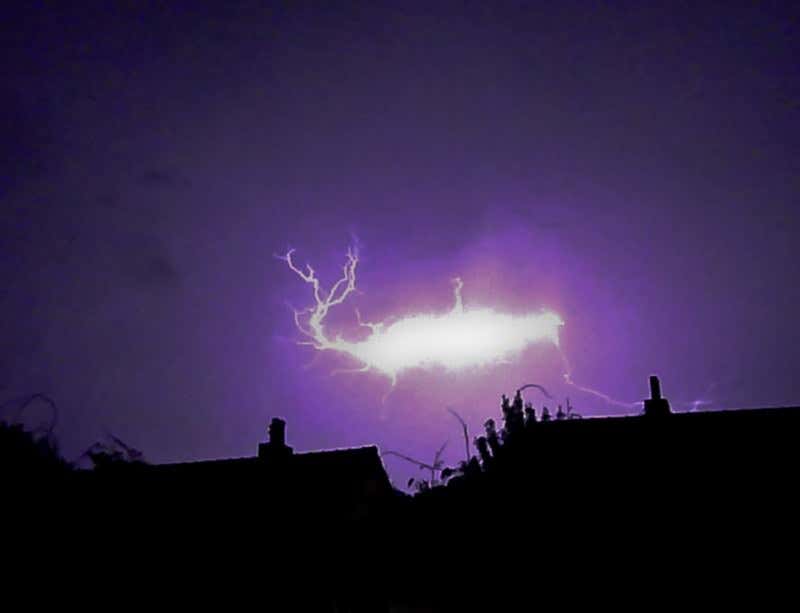Imagine a glowing sphere, the size of a basketball, floating eerily through your living room before vanishing without a trace. This is no scene from a sci-fi movie; it’s ball lightning, a phenomenon that has baffled scientists for centuries. The sphere glows with an otherworldly light, casting strange shadows on the walls. It hovers silently, then darts across the room, leaving behind a faint smell of sulfur. What is this mysterious phenomenon, and why does it continue to elude scientific explanation?

Image Credit: Wikipedia
Historical Accounts: Fact or Fiction?
One of the earliest recorded sightings of ball lightning dates back to 1195, when Gervase of Canterbury described a fiery globe descending toward the river near London. Centuries later, in 1638, an 8-foot fireball struck a church in Widecombe-in-the-Moor, England, causing destruction and injuries. The event left a lasting impression on the community, with some attributing the phenomenon to divine wrath. In 1753, physicist Georg Richmann became one of the first documented fatalities linked to ball lightning while conducting an experiment with a kite. Even at sea, sailors aboard the HMS Montague in 1749 reported a large blue fireball that exploded and damaged their ship. These historical accounts, though often dismissed as folklore, provide intriguing clues about the nature of ball lightning.
Characteristics of Ball Lightning
Ball lightning is a rare and unexplained atmospheric phenomenon. It typically appears as a glowing sphere, ranging in size from a few centimeters to several meters in diameter. The sphere can be transparent or translucent, with colors varying from red and orange to yellow and blue. Its behavior is equally mysterious: it moves unpredictably, sometimes hovering, sometimes darting erratically. Remarkably, it can pass through walls and windows without causing damage, leaving behind only a faint odor. The phenomenon is fleeting, lasting anywhere from one second to over a minute, often ending in a sudden explosion or a quiet disappearance.
Common Misconceptions
Ball lightning is often confused with St. Elmo’s fire, a continuous electrical discharge seen on ship masts or airplane wings. Unlike St. Elmo’s fire, ball lightning is a discrete, moving sphere of light. It has also been mistaken for everything from will-o’-the-wisps to alien spacecraft, adding to its air of mystery. These misconceptions highlight the challenge of studying a phenomenon that is so rarely observed and poorly understood.
Scientific Theories and Research
Scientists have proposed several theories to explain ball lightning. The vaporized silicon hypothesis suggests that ball lightning consists of vaporized silicon from the soil, ignited by a lightning strike. Another theory posits that ball lightning has a solid core surrounded by an electromagnetic field, which could explain its ability to pass through solid objects. The microwave cavity hypothesis suggests that ball lightning is a glow discharge driven by microwave radiation, possibly generated by atmospheric conditions. Despite these theories, scientists have struggled to replicate ball lightning in the lab, leaving many questions unanswered.

Image Credit: New Scientist
Recent Scientific Breakthroughs
In 2014, researchers captured the first optical spectrum of ball lightning, providing concrete evidence of its existence. The footage, recorded in China, showed a glowing sphere traveling horizontally across the frame before disappearing. This breakthrough marked a significant step forward in the study of ball lightning, but many mysteries remain. Scientists continue to investigate the phenomenon, hoping to unlock its secrets and gain insights into other atmospheric phenomena.
The Debate Continues
Despite centuries of reports, some scientists remain skeptical about the existence of ball lightning. The lack of reproducible evidence has fueled skepticism, and numerous attempts to recreate the phenomenon in controlled environments have failed. Yet, the sheer volume of eyewitness accounts and the 2014 footage suggest that ball lightning is more than just a myth. The debate continues, with researchers on both sides seeking to prove or disprove the existence of this enigmatic phenomenon.
Implications for Atmospheric Science
Understanding ball lightning could provide valuable insights into other atmospheric phenomena, such as sprites and blue jets, which are also poorly understood. If scientists can ever harness the energy behind ball lightning, it could have revolutionary applications in energy production and atmospheric science. For now, ball lightning remains one of nature’s most intriguing mysteries, a glowing reminder of how much we still have to learn about the world around us.
References:
Ball lightning – Wikipedia – link
Natural ball lightning probed for the first time | New Scientist – link
Ball Lightning Seen In Nature for First Time | Weather.com – link
Categories: Do you know, Paranormal, Science, Urban Legends
Tags: atmospheric phenomena, ball lightning, Paranormal, scientific mysteries, Urban Legends
Religion: N/A
Country of Origin: World
Topic: Ball Lightning
Ethnicity: N/A

